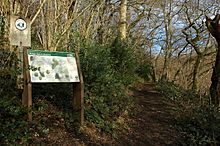Midger facts for kids
| Site of Special Scientific Interest | |

Midger nature reserve entrance
|
|
| Area of Search | Gloucestershire |
|---|---|
| Coordinates | 51°36′14″N 2°17′38″W / 51.604°N 2.294°W |
| Interest | Biological |
| Area | 65.7 hectare |
| Notification | 1966 |
Midger is a special place in England. It's a protected area called a Site of Special Scientific Interest (SSSI). This means it's really important for its plants and animals.
Midger covers about 56 hectares, which is like 100 football fields! It's located where Gloucestershire and South Gloucestershire meet. This beautiful area sits at the top of the Kilcott Valley.
Part of Midger is owned and looked after by the Gloucestershire Wildlife Trust. They work hard to protect this amazing natural space.
Contents
Discovering the Midger Wildlife Reserve
The Midger reserve is a big part of the SSSI. The Wildlife Trust bought Midger Wood in 1965 to protect it. The reserve also includes other areas like Back Common and Whitewell Wood.
Exploring the Ancient Woodland
Midger is home to very old woodlands. The main trees you'll see are ash, pedunculate oak, and field maple. There are also some crab apple and holly trees.
You might also spot beech, Scots pine, and larch trees that were planted later. Underneath the taller trees, you'll find lots of hazel bushes. Other plants here include goat willow and dogwood.
Amazing Plants of Midger
The ground in the woodland is full of interesting plants. Look for herb paris, green hellebore, and lily-of-the-valley. These grow alongside bluebells, yellow archangel, and wood anemone.
You can also find ramsons (also known as wood garlic) and wood-sorrel. Many different types of ferns also thrive here.
The Kilcott Brook stream flows through the reserve. Its edges are home to plants like opposite-leaved golden-saxifrage and pendulous sedge. The stream has small waterfalls, some of which have cool, stony deposits called tufa. In the damp valley bottom, you might see butterbur in spring and meadow saffron in autumn.
Some open areas in the reserve, like Back Common, have small clearings. These used to be places where animals grazed. Here, you'll find hawthorn and blackthorn bushes. The rough banks in the north have special limestone grassland plants. These include wild thyme, common rock-rose, and the beautiful early-purple orchid.
Wildlife Living at Midger
Midger is a fantastic place for butterflies! You might see chalkhill blue, marbled white, green hairstreak, and the rare Duke of Burgundy fritillary.
The different types of habitats here support many birds. In the woods, you could spot a treecreeper, little owl, lesser spotted woodpecker, nuthatch, marsh tit, wood warbler, or goldcrest. Near the stream, look for a dipper or grey wagtail. In the open grassy areas, you might see a meadow pipit or yellowhammer.
Other interesting animals living here include the yellow-necked field mouse, the tiny common dormouse, and fallow deer. Special nest boxes are put out to help the dormouse population grow.
Protecting Midger: Conservation Efforts
The Gloucestershire Wildlife Trust does important conservation work at Midger. They practice 'coppicing' of hazel trees. This means cutting them back to the base to encourage new growth. They also thin out young ash trees.
Another important task is clearing invasive plants like hawthorn, blackthorn, and oak from areas meant to be open grassland. This helps the special grassland plants and animals thrive.
A Royal Visit to Midger
In March 1995, Prince Charles (who is now King Charles III) visited the Midger SSSI reserve. He came to see one of the protected woodlands in the county. During his visit, he saw a demonstration of how barbecue charcoal was made. This charcoal was produced from coppiced wood and fallen timber, which was a new project for the Wildlife Trust at the time.

